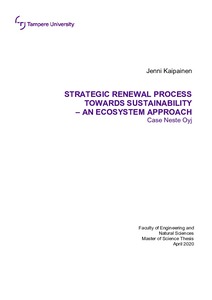Strategic Renewal Process Towards Sustainability – An Ecosystem Approach
Kaipainen, Jenni (2020)
Kaipainen, Jenni
2020
Tuotantotalouden DI-tutkinto-ohjelma - Degree Programme in Industrial Engineering and Management, MSc (Tech)
Tekniikan ja luonnontieteiden tiedekunta - Faculty of Engineering and Natural Sciences
This publication is copyrighted. You may download, display and print it for Your own personal use. Commercial use is prohibited.
Hyväksymispäivämäärä
2020-04-14
Julkaisun pysyvä osoite on
https://urn.fi/URN:NBN:fi:tuni-202004063113
https://urn.fi/URN:NBN:fi:tuni-202004063113
Tiivistelmä
Due to the ongoing sustainability megatrend, companies are increasingly incorporating environmental sustainability concerns into their strategies. Meanwhile this sustainability transition, strategic renewal processes of individual companies are inevitably co-evolving with their increasingly dynamic and complex business ecosystems. The internal rate of change in a company needs to be adjusted to that of its environment. Consequently, when companies are renewing their strategies, they need to consider not only the transition towards sustainability, but also their alignment within the constantly evolving business ecosystem and its focal value proposition. Addressing the limited existing knowledge on these issues, the objective of this study is to investigate how the process of strategic renewal towards environmental sustainability is co-evolving with its business ecosystem.
To meet the research objective, a qualitative longitudinal single-case study of extreme kind was conducted at a technological forerunner Neste Oyj. Longitudinal and multi-sourced data covered Neste’s strategy process renewal from 2000 to 2019 with 6 top management interviews, validating group discussions with interviewees and Neste strategy team, 14 annual reports from 2005 to 2018, and versatile secondary data. Data-driven and thematical analysis of the rich dataset was enhanced by mapping the longitudinal processes with critical incident technique and ecosystem mapping software Kumu.
The findings show that the mapped strategic renewal process follows the steps of formulation, implementation and evaluation meanwhile its encompassing business ecosystem follows the business ecosystem lifecycle of birth, expansion, leadership and renewal. These co-evolutionary processes in Neste case have taken place over time in four identified eras, which each have had their own critical incidents that construct sub-processes of strategic renewal. These sub-processes have been influenced by both internal and external drivers, which have discrete and ongoing natures. Identified internal drivers include organizational structure, organizational culture, competences and leadership, whereas external ones are divided into market development, regulation, collaboration, society and other drivers.
The study contributes to the intersection of strategic renewal, business ecosystem and sustainability transition literature by providing longitudinal and processual insights to an extreme case with an exceptional strategic renewal process. As for managerial implications, top management benefits from considering strategy as a cyclic process that co-evolves with its business ecosystem and acknowledging that in the early phases of this co-evolutive process, inter-nal drivers have a dominant role. Along with other internal drivers, strengthening an internal vi-sion is of high importance as it allows engagement and proactive steering of ecosystem actors through collaborations throughout the entire process of strategic renewal. When renewing a value proposition along the renewed strategy, communications with ecosystem actors play a significant role in ensuring a successful re-alignment of business ecosystem to its focal value proposition. Further, the findings of this study are useful to policymakers who consider driving measures for strategic renewal towards sustainability. For future research agenda, it is recom-mended to expand the research scope to the hindering factors and drivers which may simultaneously hinder and support the strategic renewal towards environmental sustainability.
To meet the research objective, a qualitative longitudinal single-case study of extreme kind was conducted at a technological forerunner Neste Oyj. Longitudinal and multi-sourced data covered Neste’s strategy process renewal from 2000 to 2019 with 6 top management interviews, validating group discussions with interviewees and Neste strategy team, 14 annual reports from 2005 to 2018, and versatile secondary data. Data-driven and thematical analysis of the rich dataset was enhanced by mapping the longitudinal processes with critical incident technique and ecosystem mapping software Kumu.
The findings show that the mapped strategic renewal process follows the steps of formulation, implementation and evaluation meanwhile its encompassing business ecosystem follows the business ecosystem lifecycle of birth, expansion, leadership and renewal. These co-evolutionary processes in Neste case have taken place over time in four identified eras, which each have had their own critical incidents that construct sub-processes of strategic renewal. These sub-processes have been influenced by both internal and external drivers, which have discrete and ongoing natures. Identified internal drivers include organizational structure, organizational culture, competences and leadership, whereas external ones are divided into market development, regulation, collaboration, society and other drivers.
The study contributes to the intersection of strategic renewal, business ecosystem and sustainability transition literature by providing longitudinal and processual insights to an extreme case with an exceptional strategic renewal process. As for managerial implications, top management benefits from considering strategy as a cyclic process that co-evolves with its business ecosystem and acknowledging that in the early phases of this co-evolutive process, inter-nal drivers have a dominant role. Along with other internal drivers, strengthening an internal vi-sion is of high importance as it allows engagement and proactive steering of ecosystem actors through collaborations throughout the entire process of strategic renewal. When renewing a value proposition along the renewed strategy, communications with ecosystem actors play a significant role in ensuring a successful re-alignment of business ecosystem to its focal value proposition. Further, the findings of this study are useful to policymakers who consider driving measures for strategic renewal towards sustainability. For future research agenda, it is recom-mended to expand the research scope to the hindering factors and drivers which may simultaneously hinder and support the strategic renewal towards environmental sustainability.
